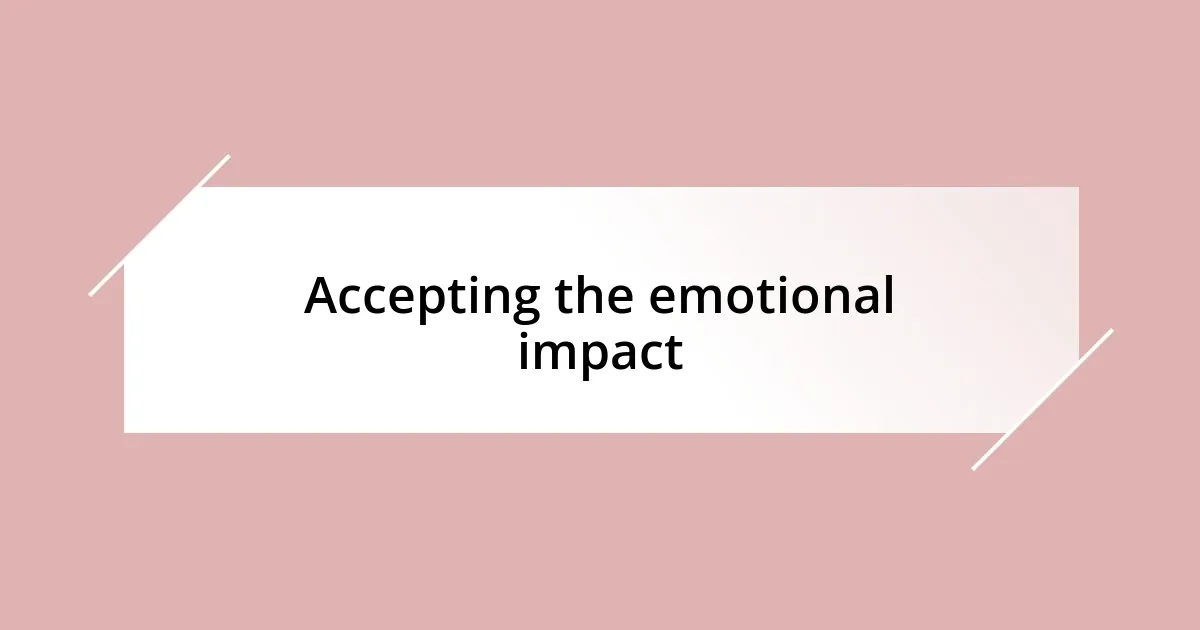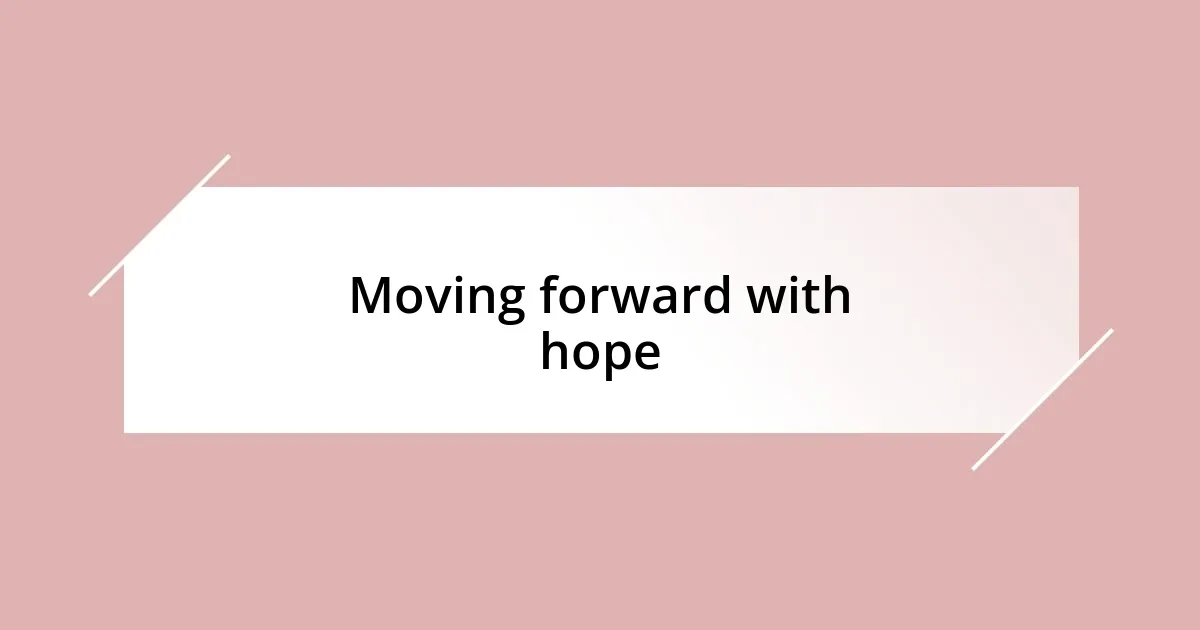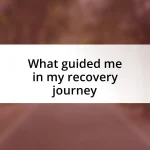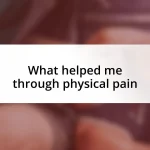Key takeaways:
- Acceptance of diagnosis is crucial for healing, providing clarity amidst uncertainty.
- Emotional processing through journaling, mindfulness, and community support helps navigate feelings.
- Active advocacy for one’s health, including open communication with healthcare providers, empowers treatment choices.
- Maintaining a self-care routine and cultivating hope are essential for resilience during the healing journey.

Understanding my diagnosis journey
Understanding my diagnosis journey was like peeling away layers of a complex onion. When I first heard the news, I felt a surge of disbelief. How could this be happening to me? It’s a question I grappled with daily until I realized that acceptance was the first step toward healing.
Through countless appointments and tests, there were days when I felt overwhelmed, almost drowning in uncertainty. I vividly remember sitting in the doctor’s office, listening to terms I hadn’t encountered before, thinking, “Will I ever understand this?” Yet, with each visit, the fog began to clear, and my perspective shifted. Knowledge became my ally in navigating the unfamiliar territory of my diagnosis.
As I connected with others who shared similar experiences, I found a sense of community that was immeasurable. Our conversations often revolved around our fears and triumphs, but what struck me was the shared understanding that we weren’t alone. How powerful it was to realize that our journeys, while unique, echoed each other’s challenges and victories! This newfound connection helped me embrace my path with resilience and hope.

Accepting the emotional impact
The emotional impact of receiving a diagnosis can feel like a tidal wave crashing over you, surfacing feelings you never anticipated. For me, the initial shock morphed into a whirlwind of emotions—anger, sadness, and fear often hijacked my days. I can recall one particular evening when I broke down, staring at the blank wall, wishing for moments of clarity amidst the confusion. It was in those depths that I realized, accepting my feelings was crucial. Suppressing them only extended my struggle.
To help navigate this emotional landscape, I found it helpful to acknowledge specific feelings and articulate them. Here are some ways that worked for me:
- Journaling: Writing down my thoughts helped me process my emotions and gain perspective.
- Talking it out: Conversations with trusted friends or support groups offered relief and a sense of shared experience.
- Mindfulness practices: Techniques like meditation allowed me to sit with my emotions rather than flee from them.
- Expressive outlets: Whether through art or music, channeling my feelings into creative forms made the emotional burden lighter.
- Physical activity: Exercise became a release, helping to dispel built-up tension and anxiety.
Accepting this emotional rollercoaster doesn’t happen overnight, but every small step towards embracing my feelings helped pave my path to healing.

Seeking support and community
Seeking support and community transformed my experience significantly. Initially, I felt isolated, but joining a local support group changed that. Sharing my journey with others who truly understood what I was going through created a bond that helped lighten my emotional load. Their experiences mirrored mine in many ways, and those moments of connection became a vital source of strength.
I remember a day when I reached out to an online community for the first time. I was nervous, typing out my thoughts and fears, but the outpouring of support was immediate. Strangers turned into friends, offering their insights and encouragement. It was surprising to feel so connected to people I had never met face to face, yet we all shared a common thread. I realized that, sometimes, community support can blossom in the most unexpected places.
It’s not just about finding a group; it’s about establishing a network that feels safe and nurturing. I found strength in various ways, whether through online forums, local meet-ups, or even social media groups focused on coping strategies. The beauty of community lies in its ability to foster resilience and collective hope.
| Support Type | Description |
|---|---|
| In-Person Support Groups | Face-to-face interactions with others who share similar experiences and challenges. |
| Online Communities | Virtual spaces where individuals can share stories and receive support regardless of location. |
| Social Media | Platforms to connect and engage with others, often resulting in meaningful conversations and support. |
| Local Meet-ups | Gatherings organized around shared interests or experiences, fostering companionship. |

Developing a coping strategy
Developing a coping strategy isn’t just a necessary step; it’s a personal journey that requires introspection and experimentation. For instance, one day, I decided to create a routine that incorporated various coping mechanisms. I often woke up early to journal my thoughts, which surprisingly set a positive tone for my day. This simple act allowed me to clear my mind, and it felt almost like preparing my emotional canvas before facing the world.
One coping strategy that truly resonated with me was the creation of a “feelings jar.” Every time I experienced a significant emotion—good or bad—I’d write it on a slip of paper and drop it in the jar. Over time, I found this practice not only helped me visualize my emotional landscape, but it also became a source of reflection. Looking back at those slips reminded me of my progress, which is often lost in the hustle of daily life.
I also found solace in setting aside time for hobbies that ignited joy. Whether it was cooking a favorite recipe or diving into a good book, these moments became a breath of fresh air amidst my emotional turmoil. How could something as simple as a good meal or an engaging story have such a profound impact? It taught me that nurturing my passions was vital; they acted as safe havens where I could regroup and recharge.

Practicing self-care techniques
Maintaining a self-care routine proved invaluable in my journey. I carved out moments each day dedicated to activities that nurtured my soul—like indulging in a warm bath or practicing mindfulness through breathing exercises. It was fascinating to observe how something as simple as taking deep breaths could transform my anxiety into calmness. Have you ever felt the weight of stress lift just by tuning into your own breath? I certainly did.
In addition to those gentle moments, physical activity became my outlet. I decided to try yoga, and the first time I rolled out my mat, I had no idea what to expect. The ebb and flow of the poses not only challenged my body but also enabled my mind to quiet its incessant chatter. Each session felt like a small celebration of my strength and resilience. I couldn’t help but think—how often do we overlook the power of movement in our healing?
Another unexpected delight was immersing myself in nature. Whenever I felt overwhelmed, I took walks in the park, letting the sights and sounds rejuvenate my spirit. Observing the vibrant colors of flowers and listening to the rustling leaves reminded me of life’s simplicity and beauty. In those moments, I was reminded that self-care isn’t just about structured activities; sometimes, it’s about savoring the world around us. What simple pleasure resonates with you, and how could it fit into your self-care routine?

Advocating for my health
Advocating for my health became a crucial turning point in my journey. I vividly remember the first time I stepped into my doctor’s office, feeling the weight of my diagnosis looming over me. It was in that moment I realized that I couldn’t just sit back and let others dictate my treatment plan. I had to be the one asking questions and seeking clarification—after all, my body was my home, and I was the only one who truly understood it.
As I navigated through this process, a significant breakthrough came when I started to voice my concerns about medication side effects. I remember discussing my experience with fatigue that was profoundly impacting my daily life. The response from my healthcare provider was enlightening; they actively adjusted my plan based on my input. How liberating it felt to know that my voice mattered! I began to understand that advocating for my health wasn’t just about speaking up; it was about fostering a partnership with my medical team.
I’ve learned that research is a powerful ally. I found myself diving deep into literature about my condition and treatment options, becoming an informed participant in my own care. It was enlightening to join online support groups where shared experiences provided validation. Have you ever felt stronger just by connecting with others who genuinely understand your journey? Ultimately, I realized that being well-informed empowered me to make choices that aligned with my values and needs.

Moving forward with hope
As I moved forward, hope became my guiding light. There were days when the prospect of healing felt distant, like trying to catch a fleeting shadow. However, I found that surrounding myself with positive affirmations and supportive voices stirred a sense of optimism within me. Have you ever found strength in a simple phrase that resonated deeply? I definitely did, and it transformed my outlook from despair to determination.
I remember a particularly tough day when I questioned if I would ever feel “normal” again. In that moment of uncertainty, I turned to my journal, pouring out my fears and aspirations. Writing became a cathartic release and a way to project hope onto the pages. By reflecting on my progress, I discovered that even small victories—like getting out of bed or sharing a laugh with a friend—were worth celebrating. Each note reinforced my belief that brighter days were ahead, nudging me to focus on what lay before me, not what held me back.
This journey has been anything but linear, filled with ups and downs. Yet, I learned to embrace the twists and turns with a sense of curiosity rather than dread. During a particularly challenging week, I stumbled upon a quote that reminded me: “Hope is the bridge that connects where I am to where I want to be.” Can you relate to that feeling of being stuck, yet wanting to push forward? It inspires me to keep journeying, cultivating hope along the way, knowing that every step, no matter how small, brings me closer to the life I envision.














